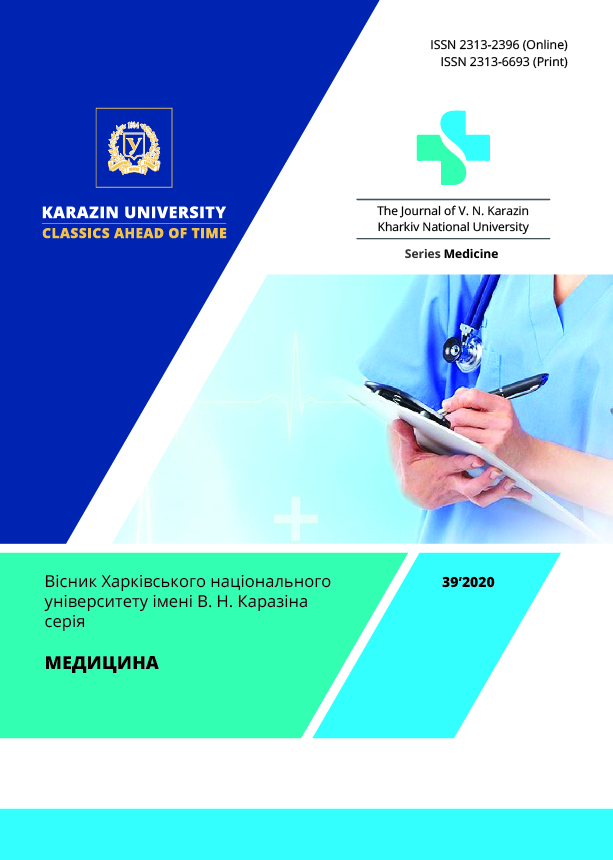Поліморфізм клінічних фенотипів і гетерогенність автоімунних мішеней міастенії
Анотація
Резюме. Метою дослідження є оцінка наявності автоантитіл до різних субодиниць нАХР і ядерних антигенів при різних фенотипах міастенії. В роботі досліджували наявність антитіл до α1- і α7-субодиниць нАХР; репертуар і частоту зустрічальності антинуклеарних автоантитіл при різних клінічних фенотипах міастенії для розуміння механізмів патогенезу різних форм даного захворювання. Виявлені додаткові фактори автоімунізації, що впливають на певні механізми патогенезу при тимуснезалежній і тимусзалежній міастенії. Виявили автоантитіла до α1- і α7-субодиниць нікотинового ацетилхолінового рецептору (нАХР) при тимуснезалежній міастенії і тимусзалежній міастенії на тлі гіперплазії тимусу або місцево-поширених тимом, а також наявність антинуклеарних антитіл при тимомах на тлі міастенії. Автоантитіла до α1-субодиниці нАХР є наявними у всіх обстежених хворих з тимуснезалежною і тимусзалежною міастенією, максимальний титр був у пацієнтів з міастенією на тлі гіперплазії тимусу. Наявність автоімунних антитіл до іншої мішені – до α7-субодиниці нАХР виявили у пацієнтів з тимуснезалежною міастенію та з міастенією на тлі гіперплазії тимусу. Виявлені антиядерні антитіла (ANA) у пацієнтів з тимомами, є переважно антитілами до структур, які беруть безпосередню участь в мітотичному поділі клітин – до центромер, до центромерного білку F, центросомного білку ахроматинового веретена – NuMa і антигену МSA-2 волокон мітотичного веретена, що впливає на перебіг клітинної проліферації, репаративні і регенеративні процеси в тканинах. Вибірковість ураження антитілами субодиниць нАХР при різних фенотипах міастенії і наявність ANA при тимусзалежній міастенії на тлі тимом має велику діагностичну та прогностичну цінність. Наявність специфічних автоантитіл до певних ядерних структур клітини, поряд з іншими механізмами автоімунізації впливає на різні метаболічні механізми, і це може бути використано для вибору адресної терапії з урахуванням індивідуальних патогенетичних мішеней автоімунного процесу.
Завантаження
Посилання
Klimova, E. M., Lavinskaya, E. V., Minukhin, D. V., Syrovaya. A. O., Drozdova, L. A., Samoilova, A. P., Makarov, V. V., Makarov, V. A., Lukianova, L. V. (2017). On Forming Central and Peripheral Markers of Self-Tolerance Loss in Diverse Clinical Myasthenic Phenotypes. Scholars Research Library/ Der Parmacia Lettre, 9 (6), 8–17. Retrieved from https://www.scholarsresearchlibrary.com/abstract/on-forming-central-and-peripheral-markers-of-selftolerance-loss-in-diverse-clinical-myasthenic-phenotypes-12424.html.
Drachman, D. B. (1994). Myasthenia gravis. N. Engl. J. Med, 330, 1797–1810. DOI: 10.1056/nejm199406233302507.
Meriggioli, M. N., Sanders, D. B. (2012). Muscle autoantibodies in myasthenia gravis: beyond diagnosis? Expert Rev. Clin. Immunol, 8(5), 427–438. DOI:10.1586/eci.12.34.
Romi, F., Skeie, G. O., Gilhus, N. E., Aarli, J. A. (2005). Striational antibodies in myasthenia gravis: reactivity and possible clinical significance. Arch. Neurol, 62 (3), 442–446. DOI: 10.1001/archneur.62.3.442.
Tovbina, M. G., Pishchik, V. G., Lapin, S. V., Nuraliev, S. M. (2017). Antibodies to striated muscle and acetylcholine receptors in evaluation of surgical treatment outcomes in patients with autoimmune myasthenia gravis. Grekov's Bulletin of Surgery Vestnik khirurgii im. I.I. Grekova, 176(3), 21-27. DOI: 10.24884/0042-4625-2017-176-3-21-27.
Klimova, E., Bozhkov, A., Avdosyev, Yu., Drozdova, L., Lavinskaya, E., Boyko, V. (2018). Myasthenogenic markers indifferent types of self-tolerance loss in patients with myasthenia gravis. International conference on Disease biomarkers and precision medicine, October 22–24, 2018. Houston, TX, USA. Retrieved from https://unitedscientificgroup.com/conferences/disease-biomarkers-and-precision-medicine/pdfs/final-program.pdf.
Fritzler, M. (2008). Challenges to the use of autoantibodies as predictors of disease onset, diagnosis and outcomes. Autoimmunity Reviews, 7(8), 616–20. DOI:10.1016/j.autrev.2008.06.007.
Alyeva, Y. B., Uzbekov, R. E. (2008). Centrosome - a polyfunctional multi-protein cell complex. Biochemistry, 73(6), 782–803. Retrieved from http://naukarus.com/tsentrosoma-polifunktsionalnyy-multibelkovyy-kletochnyy-kompleks.
Miles, S, et al. (2016). Msa1 and Msa2 Modulate G1-Specific Transcription to Promote G1 Arrest and the Transition to Quiescence in Budding Yeast. PLoS Genet 12(6):e1006088 PMID:27272642. DOI:10.1371/journal.pgen.1006088.
Grishina, T. I., Filatova G.A. (2013), Human Immune System as a Mechanism for Vivat Activity. Bulletin of RSMU, 5-6, 96–100. Retrieved from https://vestnikrgmu.ru/files/issues/2013/5-6/2013-5-6-20_ru.pdf.
Bobkova, N. V. (2015). Neurotoxicity of beta-amyloid. mechanisms, hypothesis, controversies. XI International interdisciplinary congress NEUROSCIENCE FOR MEDICINE AND PSYCHOLOGY. 87-89. Retrieved from https://istina.msu.ru/media/publications/article/d34/4ec/11668643/Sbornik_2015_Sudak.pdf.
Uzbekov, R. E., Alyeva, Y. B. (2008). THE CENTROSOME — A RIDDLE OF THE «CELL PROCESSOR». Cytology, 50(2), 91–112. Retrieved from http://www.tsitologiya.incras.ru/50_2/uzbekov.pdf.
Brinkley, B. R. (2001). Managing the centrosome numbers game: from chaos to stability in cancer cell division. Trends Cell Biol, 11, 18–21. Retrieved from https://www.ncbi.nlm.nih.gov/pubmed/11146294.
Nigg, E. (2002). Centrosome aberrations: cause or consequence of cancer progression. Nat. Rev. Cancer, 2, 15 - 25. DOI:10.1038/nrc924.
Pihan, G. A., Purohit, A., Wallace, J., Malhotra, R., Liotta, L., Doxsey, S. J. (2001). Centrosome defects can account for cellular and genetic changes that characterize prostate cancer progression. Cancer Res, 61, 2212–2219. Retrieved from https://www.ncbi.nlm.nih.gov/pubmed/11280789.
Ivina, A. A., Semkin, V. A., Babichenko, I. I. (2018). Cytokeratin 15 as a diagnostic marker for oral epithelial malignization. Stomatology, 6, 61–62. DOI:10.17116/stomat20189706161.
Nevzorov, Y. A., Evytskyi, D. Y. (2011). Tropomyosin: a double helix from the world of proteins. Advances in biological chemistry, 51, 283–334. Retrieved from https://www.fbras.ru/wp-content/uploads/2017/10/Nevzorov.pdf.
Вісник Харківського національного університету імені В. Н. Каразіна, серія Медицина має такі умови авторського права:
1. Автори зберігають авторські права та надають журналу право на першу публікацію разом із роботою, яка одночасно ліцензується згідно з ліцензією Creative Commons Attribution License, яка дозволяє іншим ділитися роботою з визнанням авторства роботи та першої публікації в цьому журналі.
2. Автори можуть укладати окремі додаткові договірні угоди щодо неексклюзивного розповсюдження опублікованої журналом версії роботи з підтвердженням її початкової публікації в цьому журналі.
3. Авторам дозволяється та заохочується публікувати свої роботи в Інтернеті до та під час процесу подання, оскільки це може призвести до продуктивного обміну, а також до раннього та більшого цитування опублікованої роботи.




